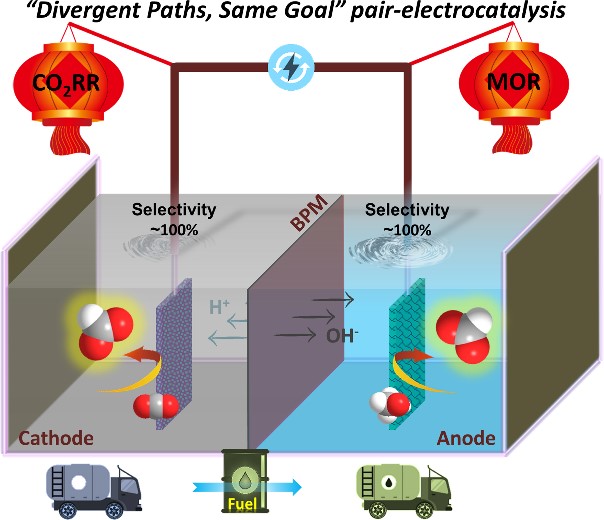
Electrosynthesis of formic acid/formate, a valuable feedstock widely used in industrial processes, through electrocatalytic CO2 reduction reaction (CO2RR), is a promising alternative protocol to industrially ways. However, the development of high-efficiency electrocatalysts is challenging. When considering the CO2 overall splitting process, the kinetically sluggish and energy-intensive oxygen evolution reaction in anode could drag down the whole electrochemical efficiency.
In a study published in Adv. Mater., the research group led by Prof. ZHU Qilong from Fujian Institute of Research on the Structure of Matter of the Chinese Academy of Sciences reported a facile pair-electrosynthesis tactic for exclusively producing formate via coupling selectively electrocatalytic methanol oxidation reaction (MOR) and CO2RR, achieving concurrent yielding of formate at both anode and cathode with greatly reduced energy input.
In the MOR-participated CO2 overall splitting system, the researchers designed and prepared the self-supported Ni- Metal-organic-framework (MOF)-derived nanosheet arrays (Ni-NF-Af) and a series of Bi-MOF-derived bismuthenes through an in situ electrochemical conversion process as efficient anodic and cathodic electrocatalysts, respectively.
They found that the as-prepared Ni-NF-Af used as the MOR electrocatalyst only needs low potentials of 1.345 and 1.388 V to deliver the industrial-scale current densities of 100 and 500 mA cm-2 for methanol-to-formate conversion with ~100% selectivity, respectively, much superior over most of the reported Ni-based electrocatalysts.
The as-prepared Bi-enes used as the CO2RR electrocatalyst can simultaneously exhibit high selectivity (> 95%), large partial current density (70 mA cm–2) and quite good stability in a potential window exceeding 0.4 V toward formate production.
The MOR-participated CO2 overall splitting system based on these distinctive MOF-derived catalysts not only can reduce the energy input exceeding 0.21 V, but also deliver high current densities and nearly 100% selectivity for formate production in both anode and cathode.
This study opens up a new way to design high-performance MOF-derived 2D electrocatalysts, and also provides a new sight into the development of more high-efficiency CO2 overall splitting system and electrosynthesis system for electrochemical production of valuable feedstocks.

A pair-electrosynthesis tactic for concurrent formate production in electrocatalytic CO2 overall splitting system via in situ MOF-derived 2D electrocatalysts. (Image by Prof. ZHU’s group)

86-10-68597521 (day)
86-10-68597289 (night)

52 Sanlihe Rd., Xicheng District,
Beijing, China (100864)

